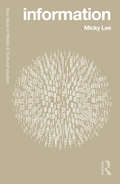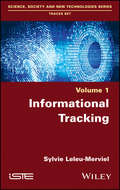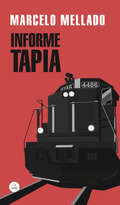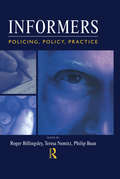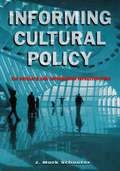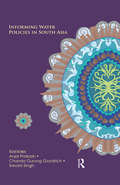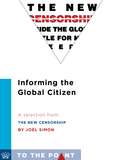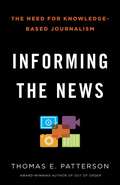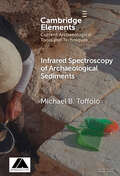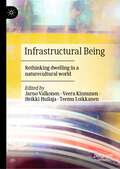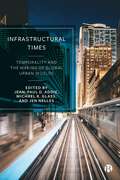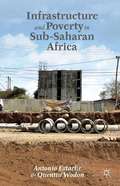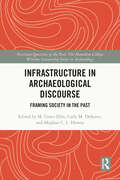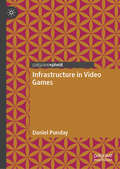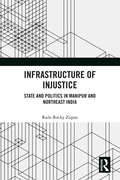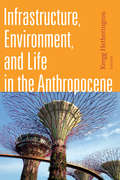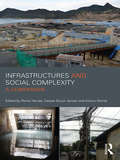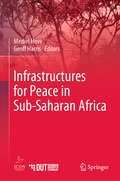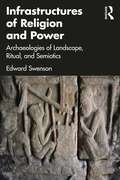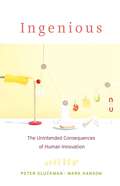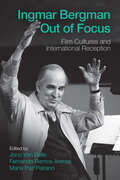- Table View
- List View
Information: Gender, Information And Financial Crises (Key Ideas in Media & Cultural Studies)
by Micky LeeThis book provides a comprehensive, easy-to-understand introductory guide to information, offering students the critical tools they need to shift their positioning from consumers and users to creators and critics. Searching, accessing, and using information are central to most daily lives. Yet, many users are not able to define what information is, identify who controls information, and create information to achieve a common good. In this book, Micky Lee teaches readers to critically interrogate key issues such as the categorization of information and knowledge throughout history, what digital divides are, why information is gender and race biased, how governments and corporations control citizens and consumers, as well as how we can resist unbalanced power relations. Readers will not only be able to relate these issues to "old" technologies, such as writing and printing, but will also be able to examine futurist technologies through the lenses of these enduring issues. A thoughtful and comprehensive overview, this is an ideal book for students and scholars of media studies, information and society, and communication and technology.
Information: Keywords
by Michele Kennerly, Samuel Frederick and Jonathan E. AbelFor decades, we have been told we live in the “information age”—a time when disruptive technological advancement has reshaped the categories and social uses of knowledge and when quantitative assessment is increasingly privileged. Such methodologies and concepts of information are usually considered the provenance of the natural and social sciences, which present them as politically and philosophically neutral. Yet the humanities should and do play an important role in interpreting and critiquing the historical, cultural, and conceptual nature of information.This book is one of two companion volumes that explore theories and histories of information from a humanistic perspective. They consider information as a long-standing feature of social, cultural, and conceptual management, a matter of social practice, and a fundamental challenge for the humanities today. Bringing together essays by prominent critics, Information: Keywords highlights the humanistic nature of information practices and concepts by thinking through key terms. It describes and anticipates directions for how the humanities can contribute to our understanding of information from a range of theoretical, historical, and global perspectives. Together with Information: A Reader, it sets forth a major humanistic vision of the concept of information.
Informational Tracking
by Sylvie Leleu-Merviel“What is colour?”, “What is the precise meaning of the statement ‘the stock exchange closes at a 5% drop this evening’?”, “How are TV viewers defined?”, or “How can images produce meaning?” Such everyday questions are examined in this book. To make our analysis intuitive and understandable, numerous concrete examples illustrate our theoretical framework and concepts. The examples include gaming, fictional skits in leisure entertainment, and enigmas. The golden thread running through the text revisits the informational process and places the datum as its pivot. The epistemological perspective of our novel approach is that of “radical relativity”. This is based on the precept that a perceptual trace carries with it the spectrum of the process that has engendered it. Given this, the informational tracking endeavour tracks the meaning-making process, notably through interpretive scaffoldings that leads to plausible realities.
Informe Tapia
by Marcelo Mellado SuazoNueva edición revisada de la gran novela de Marcelo Mellado Leopoldo Tapia, maestro de educación básica y poeta con aficiones ferroviarias, recibe la misión de preparar un reporte sobre el acoso del que estaría siendo víctima -por parte de oscuros funcionarios públicos- la Asociación de Poetas de la Cuenca del Maipo, liderada por un tal Badilla o Padilla. El pormenorizado relato de este mundo, de las jergas en que se comunican sus personajes y de los modos en que operan, hace de Informe Tapia un fresco incomparable de un cierto Chile que bien podría ser Chile entero. Publicada originalmente hace quince años, esta novela es una pieza señera en el proyecto literario de Mellado, enfocado perspicazmente en la pequeñez humana -en particular la que puede surgir en el mundo burocrático y cultural-, pero siempre atento a la comicidad y la singularidad que son su correlato objetivo, de manera que la grisura no es aquí la tónica, sino más bien cierto tono carnavalesco, paródico, hilarante.
Informers: Policing, policy, practice
by Philip Bean Teresa Nemitz Roger BillingsleyThe police rely heavily on paid and unpaid informers: without them clear-up rates would plummet, and many crimes would remain undetected. Yet little is known about the informer system and how it works, for example: who are these informers? how are they recruited? how are they handled? who handles them? what sort of information do they provide? Recent high profile cases have drawn attention to the use of informers, there has been a growing debate about the subject, and many feel that stricter controls are needed - but how is this to be achieved without undermining the effectiveness of the system? This is the first book of its kind on informers in Britain, providing an invaluable source of information and analysis from key authorities in the field.
Informing Cultural Policy: The Information and Research Infrastructure
by J. Mark SchusterIn any policy arena, the crafting of effective policy depends on the quality of the information infrastructure that is available to the participants in that arena. Such an information infrastructure is designed, developed, and managed as a critical element in policy formulation and implementation. While various attempts have been made to map the extent of the existing cultural policy information infrastructure in the United States, no structured attempt has been made to conduct a cross-national analysis intended to draw on the more highly developed models already in operation elsewhere.A cross-national comparative look provides valuable information on how this infrastructure has evolved, on what has succeeded and what has had less success, on what is sustainable and what is not, and on how the range of interests of the various individuals and institutions involved in the cultural policy arena can best be accommodated through careful design of the information infrastructure.In Informing Cultural Policy, international cultural policy scholar and researcher J. Mark Schuster relates the findings of a study that took him from North America to Europe to gain understanding of the cultural policy information infrastructure in place abroad. His findings are structured into a taxonomy that organizes the array of research and information models operating throughout the world into a logical framework for understanding how the myriad cultural agencies collect, analyze, and disseminate cultural policy data. Schuster discusses private- and public-sector models, including research divisions of government cultural funding agencies, national statistics agencies, independent nonprofit research institutes, government-designated university-based research centers, private consulting firms, cultural ""observatories,"" non-institutional networks, research programs, and publications. For each case study undertaken, the author provides the Internet address, names, and information for key conta
Informing Water Policies in South Asia
by Anjal Prakash Chanda Gurung Goodrich Sreoshi SinghThis book analyzes water policies in South Asia from the perspective of Integrated Water Resources Management (IWRM). It seeks to address the problems of water scarcity, conflict and pollution resulting from the gross mismanagement and over-exploitation of this finite resource. Highlighting the need for IWRM in mitigating abuse and ensuring sustainable use, it discusses issues relating to groundwater management; inter-state water conflicts; peri-urban water use; local traditional water management practices; coordination between water users and uses; and water integration at the grassroots level. With case studies from India, Bangladesh, Pakistan, and Nepal, the innovative, painstaking and transnational researches presented in the volume deal with questions of equity, gender, sustainability, and democratic governance in water policy interventions. It will interest researchers and students of development studies, environmental studies, natural resource management, water governance, and public administration, as also water sector professionals, policymakers, civil society activists and governmental and nongovernmental organizations.
Informing the Global Citizen: A Selection from The New Censorship: Inside the Global Battle for Media Freedom (To the Point)
by Joel SimonToday, anyone with an iPhone can provide firsthand accounts from the world's front lines. Despite our increased access to events around the world, journalists are more vital than ever as they bring context and perspective and help to set the humanitarian agenda. However, threats to journalists are mounting with record numbers killed and imprisoned each year. From the drug wars of Mexico to Iraq and Tahrir Square, Joel Simon explores the new challenges and dangers to the future of journalistic freedom.
Informing the Global Citizen: Inside the Global Battle for Media Freedom
by Joel SimonToday, anyone with an iPhone can provide firsthand accounts from the world's front lines. Despite our increased access to events around the world, journalists are more vital than ever as they bring context and perspective and help to set the humanitarian agenda. However, threats to journalists are mounting with record numbers killed and imprisoned each year. From the drug wars of Mexico to Iraq and Tahrir Square, Joel Simon explores the new challenges and dangers to the future of journalistic freedom.
Informing the News
by Thomas E. PattersonAs the journalist Walter Lippmann noted nearly a century ago, democracy falters "if there is no steady supply of trustworthy and relevant news." Today's journalists are not providing it. Too often, reporters give equal weight to facts and biased opinion, stir up small controversies, and substitute infotainment for real news. Even when they get the facts rights, they often misjudge the context in which they belong. Information is the lifeblood of a healthy democracy. Public opinion and debate suffer when citizens are misinformed about current affairs, as is increasingly the case. Though the failures of today's communication system cannot be blamed solely on the news media, they are part of the problem, and the best hope for something better. Patterson proposes "knowledge-based journalism" as a corrective. Unless journalists are more deeply informed about the subjects they cover, they will continue to misinterpret them and to be vulnerable to manipulation by their sources. In this book, derived from a multi-year initiative of the Carnegie Corporation and the Knight Foundation, Patterson calls for nothing less than a major overhaul of journalism practice and education. The book speaks not only to journalists but to all who are concerned about the integrity of the information on which America's democracy depends.
Infrared Spectroscopy of Archaeological Sediments (Elements in Current Archaeological Tools and Techniques)
by Michael B. ToffoloInfrared spectroscopy is the study of the interaction between infrared radiation and matter. Its application to the characterization of archaeological sedimentary contexts has produced invaluable insights into the archaeological record and past human activities. This Element aims at providing a practical guide to infrared spectroscopy of archaeological sediments and their contents taken as a dynamic system, in which the different components observed today are the result of multiple formation processes that took place over long timescales. After laying out the history and fundamentals of the discipline, the author proposes a step-by-step methodological framework, both in the field and the laboratory, and guides the reader in the interpretation of infrared spectra of the main components of archaeological sediments with the aid of selected case studies. This title is also available as Open Access on Cambridge Core.
Infrastructural Being: Rethinking dwelling in a naturecultural world
by Jarno Valkonen Veera Kinnunen Heikki Huilaja Teemu LoikkanenThis book provides a comprehensive insight into the contemporary naturecultural world by exploring infrastructures through the dwelling approach. The notion of naturecultures has been utilized in environmental humanities and social sciences to emphasize the inherent messiness of the lived world and the inseparability of social and biophysical elements. Concept of naturecultures stresses that seemingly “natural” is always simultaneously “cultural” and vice versa. This approach allows fleshing out the messy engagements with infrastructures, which in this book is conceptualized as infrastructural being. This book is a contribution to emerging discussions on infrastructures in the fields of environmental social sciences and humanities. It sensitizes to the peculiarities of modern dwelling and modern, yet often overlooked, ways of being connected with nature. Moreover, it provides tools for speculating, how could things be otherwise. The book is a topical response to the urgent call for developing new forms of human-nature relations in times of environmental turbulence.
Infrastructural Times: Temporality and the Making of Global Urban Worlds
by Jean-Paul D. Addie, Michael R. Glass, and Jen NellesWhether waiting for the train or planning the future city, infrastructure orders—and depends on—multiple urban temporalities. This agenda-setting volume disrupts conventional notions of time through a robust examination of the relations between temporality, infrastructure, and urban society. Conceptually rich and empirically detailed, its interdisciplinary dialogue encompasses infrastructural systems including transportation, energy, and water to bridge often-siloed technical, political-economic and lived perspectives. With global coverage of diverse cities and regions from Berlin to Jayapura, this book is an essential provocation to re-evaluate urban theory, politics, and practice and better account for the temporal complexities that shape our infrastructured worlds.
Infrastructure and Poverty in Sub-Saharan Africa
by Quentin Wodon Antonio EstacheInfrastructure and Poverty in Sub-Saharan Africa analyzes the extent to which, how, and how fast the infrastructure needs of the poor have been met in Sub-Saharan Africa. Estache and Wodon explore the extent to which some key policies have hurt or helped progress in trying to speed the expansions of coverage so clearly needed in the region. They focus on electricity, water, sanitation, and other services at the core of the day-to-day needs of the population, examining the extent to which reforms of the last 15-20 years have managed to reduce the infrastructure gap. They anchor their analysis on the evidence available about the macroeconomic importance of infrastructure for the region, the policies that have been adopted to accelerate coverage, and a detailed assessment of the poverty dimensions of infrastructure.
Infrastructure in Archaeological Discourse: Framing Society in the Past (Persistent Questions of the Past)
by M. Grace Ellis Carly M. DeSanto Howey, Meghan C. L.This volume expands perspectives on infrastructure that are rooted in archaeological discourse and material evidence.The compiled chapters represent new and emerging ideas within archaeology about what infrastructure is, how it can materialize, and how it impacts and reflects human behavior, social organization, and identity in the past as well as the present. Three goals central to the work include: (1) expand the definition of infrastructure using archaeological frameworks and evidence from a wide range of social, historical, and geographic contexts; (2) explore how new archaeological perspectives on infrastructure can help answer anthropological questions pertaining to social organization, group collaboration, and community consensus and negotiation; and (3) examine the broader implications of an archaeological engagement with infrastructure and contributions to contemporary infrastructural studies. Chapters explore important aspects of infrastructure, including its relationality, scale, history, and relevance, and provide archaeological case studies that examine the social repercussions of infrastructure and the various ways it has materialized in the past. This compilation ultimately expands the discourse of infrastructure in archaeology and social sciences more broadly.Social scientists can turn to this volume for insights into an archaeologically informed perspective on infrastructure relevant to the study of past and current human behavior.
Infrastructure in Video Games
by Daniel PundayThis book will sketch the dynamics of infrastructure in video games, focusing on the relationship between game rules, fictional world, and player interaction. It will discuss a variety of commercial video games, both mainstream and somewhat niche, that use infrastructure in different ways: Control, Wolfenstein, Fallout, This War of Mine, Exocolonist, Cyberpunk, and Frostpunk. Video games offer a particularly rich field for thinking about the relationship between narrative and infrastructure. The infrastructures that exist in the fictional worlds of these games define the experience of play in a very direct way: how players are instantiated in the game, how they move around the play space, the resources that are available, and so on. And those infrastructures in turn very directly definite the nature of the fictional world. In contrast to literary fiction, were infrastructures might remain on the periphery of some stories, by virtue of the centrality of player interaction video games are inherently infrastructural.
Infrastructure of Injustice: State and Politics in Manipur and Northeast India
by Raile Rocky ZiipaoThis book examines the dynamics of infrastructure development in Northeast India especially Manipur from a socio-anthropological perspective. It looks at the pattern and distribution of infrastructure in the region to analyse the impact of education, roads and healthcare on the livelihoods, ecosystems, governance, and social futures of communities. The volume examines the infrastructure deficit in the conflict-ridden state of Manipur, focusing especially on electricity and roads. The author shows how problems arising from poor infrastructure are further complicated on account of corruption, insurgency, ethnic unrest and the politics of marginalization. Looking at the discourse around development in the Northeast, the volume also highlights the structural inequality in Manipur and other states. It further shows how infrastructure development can become a means for enabling trade, creating markets, diluting boundaries between varied ethnic groups and connecting people. This book will be useful for researchers and scholars of development studies, economics, social anthropology, sociology and public policy; particularly those interested in India’s Northeast.
Infrastructure, Environment, and Life in the Anthropocene (Experimental Futures)
by Kregg HetheringtonInfrastructure, Environment, and Life in the Anthropocene explores life in the age of climate change through a series of infrastructural puzzles—sites at which it has become impossible to disentangle the natural from the built environment. With topics ranging from breakwaters built of oysters, underground rivers made by leaky pipes, and architecture gone weedy to neighborhoods partially submerged by rising tides, the contributors explore situations that destabilize the concepts we once relied on to address environmental challenges. They take up the challenge that the Anthropocene poses both to life on the planet and to our social-scientific understanding of it by showing how past conceptions of environment and progress have become unmoored and what this means for how we imagine the future. Contributors. Nikhil Anand, Andrea Ballestero, Bruce Braun, Ashley Carse, Gastón R. Gordillo, Kregg Hetherington, Casper Bruun Jensen, Joseph Masco, Shaylih Muehlmann, Natasha Myers, Stephanie Wakefield, Austin Zeiderman
Infrastructures and Social Complexity: A Companion (CRESC)
by Casper Bruun Jensen Atsuro Morita Penelope HarveyContemporary forms of infrastructural development herald alternative futures through their incorporation of digital technologies, mobile capital, international politics and the promises and fears of enhanced connectivity. In tandem with increasing concerns about climate change and the anthropocene, there is further an urgency around contemporary infrastructural provision: a concern about its fragility, and an awareness that these connective, relational systems significantly shape both local and planetary futures in ways that we need to understand more clearly. Offering a rich set of empirically detailed and conceptually sophisticated studies of infrastructural systems and experiments, present and past, contributors to this volume address both the transformative potential of infrastructural systems and their stasis. Covering infrastructural figures; their ontologies, epistemologies, classifications and politics, and spanning development, urban, energy, environmental and information infrastructures, the chapters explore both the promises and failures of infrastructure. Tracing the experimental histories of a wide range of infrastructures and documenting their variable outcomes, the volume offers a unique set of analytical perspectives on contemporary infrastructural complications. These studies bring a systematic empirical and analytical attention to human worlds as they intersect with more-than-human worlds, whether technological or biological.
Infrastructures for Peace in Sub-Saharan Africa
by Mediel Hove Geoff HarrisCultures of violence are characteristic of many countries in sub-Saharan Africa and attempts to move towards cultures of peace have often proved difficult and ineffectual. And yet, the wide variations in levels of violence within and between countries show that it is not inevitable; rather, it is the result of choices made at individual, community and societal levels. This book examines the potential of peace infrastructures as vehicles to strengthen and spread progress towards cultures of peace. Peace infrastructures vary hugely in sophistication and level. The examples examined in this book range from tiny structures which help resolve conflicts between individuals and within community organisations, peace committees which serve local communities, peace education and peace club programmes in schools, mediation mechanisms to prevent election violence and to ministries of peace to coordinate government and non-government efforts in peacemaking and peacebuilding. The overall finding is that the development of peace infrastructures at all levels has great potential to build cultures of peace. 1. It is the only book available which documents the experience and potential of nonviolence in post-independence sub-Saharan Africa. 2. It makes a persuasive case for the development of various peace infrastructures in order to make peace sustainable. 3. It explains how strategic planning can be utilised, both to bring about change and to institutionalise it.
Infrastructures of Religion and Power: Archaeologies of Landscape, Ritual, and Semiotics
by Edward SwensonThis book explores the central role of religion in place-making and infrastructural projects in ancient polities. It presents a trilectic approach to archaeological study of religious landscapes that combines Indigenous philosophies with the spatial and semiotic thinking of Lefebvre, Peirce, and proponents of assemblage theories. Case studies from ancient Angkor and the Andes reveal how rituals of place-making activated processes of territorialization and semiosis fundamental to the experience of political worlds that shaped power relations in past societies. The perspectives developed in the book permit a reconstruction of how landscapes were variably conceived, perceived, and lived in the spirit of Henri Lefebvre, and how these registers may have aligned or clashed. In the end, the examination of built environments, infrastructures, and rituals staged within specialized buildings demonstrates how archaeologists can better infer past ontologies, cosmologies, ideologies of time and place, and historically specific political struggles. The study will appeal to students and researchers interested in ritual, infrastructures, landscape, archaeological theory, political institutions, semiotics, human geography, and the civilizations of the ancient Andes and Angkor.
Infrastructuring Urban Futures: The Politics of Remaking Cities
by Alan Wiig, Kevin Ward, Theresa Enright, Mike Hodson, Hamil Pearsall and Jonathan SilverEPDF and EPUB available Open Access under CC-BY-NC-ND licence. Focusing on material and social forms of infrastructure, this edited collection draws on rich empirical details from cities across the global North and South. The book asks the reader to think through the different ways in which infrastructure comes to be present in cities and its co-constitutive relationships with urban inhabitants and wider processes of urbanization. Considering the climate emergency, economic transformation, public health crises and racialized inequality, the book argues that paying attention to infrastructures’ past, present and future allows us to understand and respond to the current urban condition.
Ingenious: The Unintended Consequences of Human Innovation
by Peter Gluckman Mark HansonThe trouble with innovation is that it can seldom be undone. We invent technologies to modify our environments in immediately beneficial ways, but the long-term consequences can be costly. From obesity to antibiotic resistance, we pay for our successes. Peter Gluckman and Mark Hanson explore what happens when our creations lead nature to bite back.
Inglorious Royal Marriages
by Leslie CarrollIt's no secret that the marriages of monarchs are often made in hell. Here are some of the most spectacular mismatches in five hundred years of royal history.... In a world where many kings, queens, and princes lacked nothing but true love, marital mismatches could bring out the baddest, boldest behavior in the bluest of bloodlines. Margaret Tudor, her niece Mary I, and Catherine of Braganza were desperately in love with chronically unfaithful husbands, but at least they weren't murdered by them, as were two of the Medici princesses were. King Charles II's beautiful, high-spirited sister "Minette" wed Louis XIV's younger brother, who wore more makeup and perfume than she did. Forced to wed her boring, jug-eared cousin Ferdinand, Marie of Roumania--a granddaughter of Queen Victoria--proved herself one of the heroines of World War I by using her prodigious personal charm to regain massive amounts of land during the peace talks at Versailles. Brimming with outrageous real-life stories of royal marriages gone wrong, this is an entertaining, unforgettable book of dubious matches doomed from the start.
Ingmar Bergman Out of Focus: Film Cultures and International Reception
by Jono Van Belle, Fernando Ramos Arenas, and María Paz PeiranoDirector Ingmar Bergman occupies a central place in the history of modern cinema. Credited with igniting a cinematic revolution, his ability to produce work which resonated with audiences globally has brought scholarly attention to the impact of Bergman’s Swedish background on his oeuvre. Ingmar Bergman Out of Focus revises this question of Bergman’s “familiarity” to produce a more expansive understanding of Bergman’s cultural heritage. Considering the impact of Bergman’s films on film festival organizers, critics, academics, and audiences all over the world, this volume illuminates how Bergman’s film aesthetics simultaneously shaped modern culture and were themselves reshaped by the debates and concerns that preoccupied his viewers.
